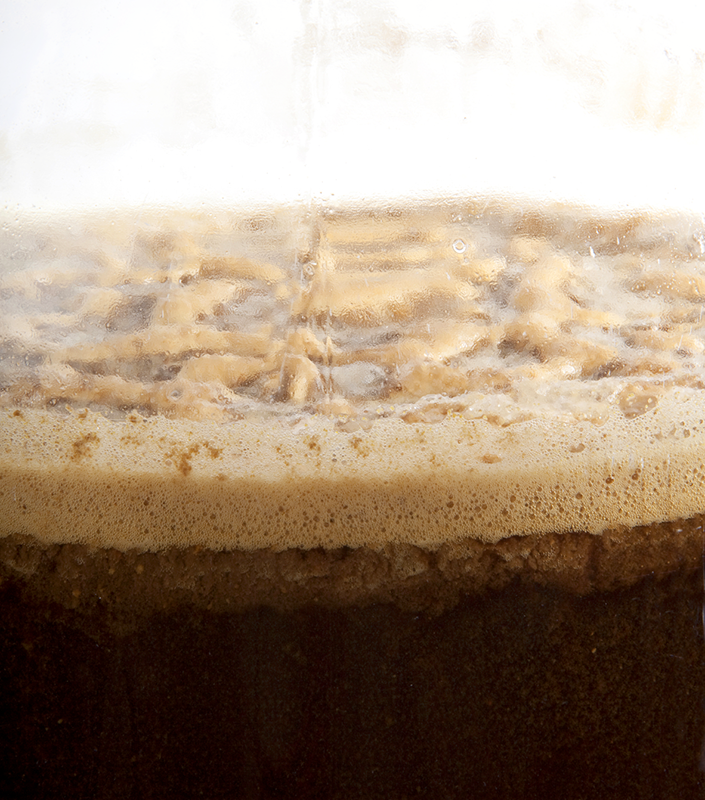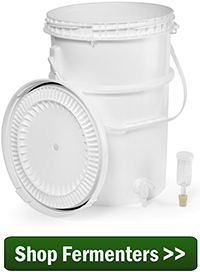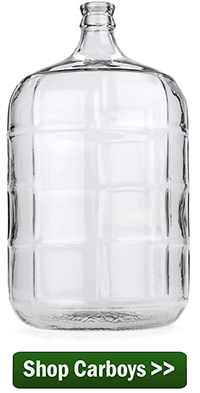 If you’ve ever shopped around for a new fermenter, you’ve probably asked yourself this question: What are the advantages and disadvantages of fermentation buckets vs. carboys?
If you’ve ever shopped around for a new fermenter, you’ve probably asked yourself this question: What are the advantages and disadvantages of fermentation buckets vs. carboys?
As a beginning homebrewer, it may be hard to find a definitive answer to the question. Ask other brewers, and you’ll probably get a range of opinions. It seems that everyone has their preference.
But there’s a reason that homebrew equipment kits include a bucket fermenter for primary fermentation and a carboy for secondary fermentation. It all comes down to a few pros and cons:
Buckets
- Wide mouth offers easy access – The design of a fermenting bucket makes it easy to pour into from the boil kettle – you don’t have to mess with a funnel. It’s also easy to open the lid to pull hydrometer samples or add dry hops or other flavorings.
- Lots of headspace – Buckets offer lots of room for krausen during primary fermentation.
- Plastic is lightweight and unlikely to break – Buckets are easier to move than glass. Plus, if you drop one, it won’t shatter and send you to the ER.
- Easy to clean – It’s easier to get inside a bucket to clean the insides. If you need to, you can really get in there and scrub.

Carboys
- Great for bulk aging – With carboys, it’s easy to minimize headspace. Reducing the amount of beer that comes in contact with air greatly reduces the chances of oxidation and infection.
- A window to your fermentation – Carboys are clear, so you can see what’s happening inside.
- They come in glass and plastic options – Some brewers feel like they get better flavor when fermenting in glass.
- Don’t provide much space for primary fermentation – To give the krausen room to grow, you may need to rig up a blowoff tube.
- Can be difficult to clean – Since the opening at the top is so small, it can be hard to get inside for a deep clean. We recommend using a carboy brush or an automatic carboy washer to really get inside.

Conclusion
Though both fermentation buckets and carboys work well for fermenting beer, buckets tend to be best for primary fermentation and carboys for secondary fermentation and aging. If you anticipate needing to get inside the fermenter during fermentation (to add dry hops or to stir a mead), a bucket may be your best bet. If you plan to age a beer for a long time after primary fermentation, consider using a carboy to minimize headspace. So as you can start to see there is some commonsense arguments for using a fermentation bucket vs using a carboy.
Which do you prefer: fermentation bucket or carboy?
—–
David Ackley is a writer, brewer, and craft beer marketing consultant. He holds a General Certificate in Brewing from the Institute of Brewing and Distilling and is founder of the Local Beer Blog.

I much prefer buckets for primary fermentation, and usually use the 7.8 gallon wine kit size as opposed to the 6.9 included in most beer kits. If you like big beers, you need that extra space for all the foam produced by the bigger beers. If I do need a blow-off still, I use a 2 gallon bucket, sanitize it, and have two grommets in the 2 ga. lid, one for a 1/4″ or 3/8″ blowoff tube and one for an airlock. When it is done with the blown-off portion, I put it right back in the fermenter, since I assume that blown off portion was probably some of the healthiest yeast in the batch. I have a Creme Brulee beer I make that produces 4 gallons of krausen/foam for a 6 gallon batch.
Gotta agree with the majority here and say that I am also a big fan of plastic buckets. They are cheap, do the job, and are affordable to replace. I have seen too many pictures of glass carboy mishaps that my plastic buckets will suit me just fine.
I would be interested in potentially switching to a PET carboy, such as the Big Mouth Bubbler. Heard a lot of good things about that, so we’ll see once it comes time to replace what I already have now.
I wouldn’t recommend a Big Mouth Bubbler until the fix the issues with the lid.
i realy enjoy reading anything to do with wine makeing. you guys have helped me more then you know. i realy appreciate you all .i use bucket and carboys thanks again stacie wagle
Stacie, we are glad that you have found our information helpful.
I use both. Bucket for primary and plastic carboy for secondary. Works great for me.
Plastic buckets with cover on it and perhaps a fermentation airlock if you are fermenting beer or wine in places filled with tons of wild yeast floating in air as in most humid places that have lots of plant matter growing over the lands.. If not .. a plastic sheet to cover your open bucket works just fine if your fermentation area is clean and free of floating air contaminants and particulates. Sanitation of equipment and tools use is of the utmost importance.. Plastic carboys for short term shortage is fine.. but it you decide to keep your wort or must for many months ..even years.. then glass only. As plastic leeches chemicals over long term.. I have beer stored away in glass carboy ageing away for over 4 yrs now.. and it is just as good as the day it went into storage.. Most of my wines .. if in kit form they often say .. its ready to drink in 28 days to 60 days.. Rubbish I say!! All of my wines age in carboys from 1 to 3 yrs.. before I get to bottling them .. even if you make wine from real grapes you grow yourself or from fruit grown at home.. such as Rhubarb.. then when you bottle wine for example .. you should have high end long term storage corks for bottles that will be stored for years… .. as well as low end corks meant to permit rapid guzzling of vino after you bottled the wine and you want to pound down quickly.. . How and where you store your wine is important … as it is with beer. Both will last a long time via long term storage often getting better with age.. For Beer I am a keg guy..and once my beers are in one of my many Cornelius tanks.. I bottle the rest to Grolsch style bottles that can be burp from time to time.. as pressure can build causing bottles to explode if too much priming sugar was used.. I also keep beer in bottles often over a year before I get to it..As consumption from keg keeps the beer flowing without allot of work in cleaning and prepping beer bottles take. And finally with the continuous rising costs of wine and beer. This really is the best way to go should anyone want to save money, is by the DIY method.. Do It Yourself. !!
Wondering, if you could offer some insight, as how much head room you can have and still be safe. I have four gal of wine in a primary fermentor,and will be transferring to a five gal carboy as a secondary,will it be ok to leave that much space in the carboy? can i top it off with a gallon of some other wine..? Not crazy about using that much h2o.
Gary, having a gallon of headspace is too much empty space. This could cause oxidation or spoilage of the wine. Yes, you can top it up with another wine of similar character. There are also other ways to deal with excess space as explained in the article posted below.
Topping Up Your Homemade
https://eckraus.com/wine-making-topping-up
They make 3 gallon carboys and one gallon jugs. If you don’t want to add water or adjust the taste with a different wine, that might be a good option. I use my 3 gallon to age my wine at times and only bottle half